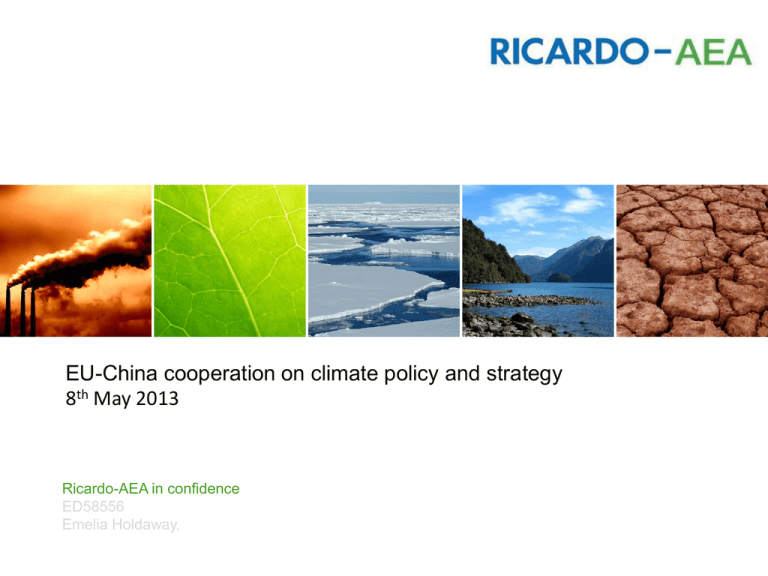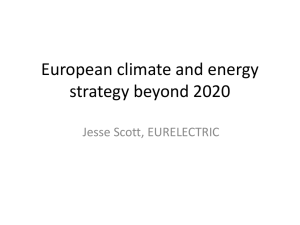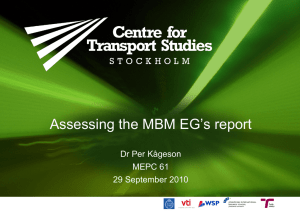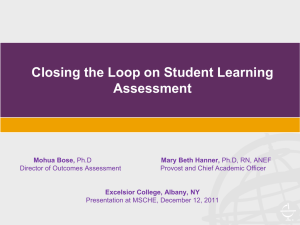UK ETS integration into EU ETS - Ricardo-AEA
advertisement

EU-China cooperation on climate policy and strategy 8th May 2013 Ricardo-AEA in confidence ED58556 Emelia Holdaway, Agenda 1. Introduction to Ricardo-AEA 2. Spotlight: White Certificate Trading Systems 3. Spotlight: Support to Feasibility Study of Linking Guangdong and Hubei Provincial ETSs Pilots UK ETS integration into EU ETS 4. Other examples of project experience 1. Introduction to Ricardo-AEA Overview Ricardo - AEA is one of the world’s leading energy and climate change consultancies, with over 220 climate change and sustainability experts, providing analysis and solutions for major environmental challenges worldwide. We have worked at the heart of ground breaking technical and policy developments across the environmental spectrum for the last 40 years, and continue to play a lead role as advisor to governments, international institutions and major corporations. • Heritage • Air quality and clean air policy -1950’s • Energy efficiency and consequences of oil crisis 1970’s • Climate change and sustainability -1980’s • Resource efficiency and resource productivity- present • Domain expertise Climate change, energy, water management, resource productivity and security, air quality, waste and recycling, chemical risk and sustainable transport • Services Strategic consultancy, economic modelling, project leadership and data management Ricardo-AEA Worldwide Deploying Electric Vehicles (DoT) CLIMA East Mitigation & Adaptation (EuropeAid) EMEA Climate Council (Citibank) Japan City Transport Model (FCO) Riyadh Air Quality Management China White Certificate Schemes (World Bank) Ethiopia Climate Smart Initiative (WB) Kenya National MRV+ Framework (DANIDA) Brazil Energy Planning Models (FCO) Chile Carbon Market Design (WB) • • • • India Lessons from UK & EU (DFID) Urban Transport Modelling (GEF) South Africa (GIZ) GHG Projections Climate M&E Thailand & Indonesia GHG Reporting (GIZ) Waste to Energy Review (Zero Waste South Australia) Global Projects • Climate & Environment “Evidence on Demand” framework (UK DFID) • Climate Negotiator Training for LDCs (UK CDKN) • Nanotechnology in Tyres (OECD) 8 2. Spotlight: White Certificate Trading Systems (World Bank) Project overview (1/2) • This project aims to bring lessons from international experience on how to design energy savings certificates (white certificates) schemes - especially when they co-exist with other market – based measures (e.g. renewable energy certificates, carbon cap-and-trade mechanisms) • Context: − Target of 16% reduction in energy intensity during 12th FYP – with a mix of policy instruments to achieve this goal − Plans for pilot Energy Savings Certificate Trading; in parallel, pilot carbon trading established to help achieve 17% carbon intensity reduction in 12th FYP – scope for overlap since significant portion of carbon savings come from energy efficiency projects. Project overview (2/2) • The project seeks to address the following key policy questions: • What is the rationale for having multiple instruments and targets? • What design considerations were applied to develop co-existing systems? • How effective have co-existing systems been – MWh and tCO2 saved? Consortium Project lead Danish Energy policy specialist Chinese Energy policy specialist Methodology International review • Literature • Interviews • Report Recommendations March – May 2013 • International learning • Chinese context Workshop May- June 2013 • Engage with Chinese policy-makers Report Early June 2013 June 2013 Scope of international systems Country/ Region UK System Italy • Titoli di Eficienza Energetica (White certificates) • EU Emissions Trading System • Certificati Verdi (Renewable quota system) India • Perform, Achieve, Trade • Renewable Energy Certificate system California • Energy Efficiency Obligation programmes (various) • Carbon cap and trade • Renewable Portfolio standard • Carbon Emissions Reduction Target (CERT – white certificates) • EU Emissions Trading System • Renewables Obligation Detailed assessment of international schemes Examine design choices for the following elements (across all systems examined) Scope and coverage (energy, sectors) Baselines and targets (level of target, type of target, how targets determined) Allocation mechanisms Monitoring, Reporting and Verification Eligible technologies Institutional arrangements Linkages 2. Support to Feasibility Study of Linking Guangdong and Hubei Provincial ETSs Pilots (British Foreign and Commonwealth Office, Tsinghua University) Project overview • Supporting Tsinghua University’s project to assess technical barriers and feasibility of linking the Guangdong and Hubei Provincial ETS pilots. • Reviewing international experience and developing recommendations for China based specifically on: − the EU-Australia carbon market linkage − UK ETS integration into ETU ETS − The distribution of allowances among EU Member States and transactions between them − Models used to estimate abatement potential & costs − How to address carbon leakage & its impact on linking. Overview: current international links Current links: • • • California and Quebec (last month). EU ETS and Australia. Norway, Iceland and Liechtenstein joined the EU ETS in 2007; link with Switzerland is currently being negotiated. Linkages that are under discussion: • Australian and New Zealand – official announcement has yet to be made. • Australia and California– official talks have started on possible linking mechanisms. UK ETS integration into EU ETS Overlap rather than linking ~ exemption required equivalence Two year overlap Scheme Timing Participants UK ETS 2002 – 2006 For companies (voluntary) Phase 1 EU ETS (pilot phase) 2005 – 2007 For installations (mandatory) 63 common installations • UK lobbied the European Commission for temporary exclusion of common installations, if schemes were equivalent. Useful insights for linking because UK ETS had to demonstrate equivalence with EU ETS in three areas: ambition, penalties and MRV Ambition (1/2) – comparison of approaches Scheme UK ETS Scheme Voluntary Administrator Defra Phase 1 EU ETS Mandatory European Commission Method MS had flexibility regarding how EUAs were allocated between installations via the NAPs (NAPs in line with MS’ Kyoto commitments) Target Baseline Different levels of ambition in different company proposals (although scheme aims to meet Kyoto commitments) Company GHG emission reduction target over 5 years 2000 baseline (‘98,’99,’00 average) Installation-level CO2 free allocation over 3 years ~ reduction target 2000 baseline Ambition (2/2) – making UK ETS equivalent • UK targets were ‘converted’ into EU targets, and then UK company-level targets tightened to show equivalence at an installation-level (target was raised if lower than NAP allocation and kept if higher to comply with UK ETS). To adequately compare equivalence of ambition, data must be available for equivalent baseline periods and ambition must be robustly understood (transparency). Penalties (1/2)– comparison of approaches Scheme Make-good provision Penalty UK ETS If installation not meet its target subtraction from subsequent year’s allocation, with potential of using a penalty factor as a multiplier No penalty incentive only paid if installation has sufficient allowances. Phase 1 EU ETS If installation not report sufficient allowances requirement to buy extra tonne in subsequent year Fixed penalty of €40 for each tCO2 that installation not hold an EUA for Penalties (2/2) – making UK ETS equivalent • The UK Government had to demonstrate that the penalties were equivalent: − Introduced a penalty of £30 (≈€45) for each tCO2 that the installation not hold an emissions unit for (different currency, UK ETS penalties more severe) Penalties should be comparable, but may need not be exactly the same – important to ensure that companies are equally dis/advantaged between the schemes. MRV (1/2)– comparison of approaches Scheme Reporting UK ETS Phase 1 EU ETS Equivalent regarding how to report on sources of emissions - additional rules to establish company boundaries Equivalent regarding how to report on sources of emissions - no additional rules for companies because installation based Emission sources Imported elect, heat or steam used on site – included; Generation of elect, heat or steam exported offsite excluded Imported elect, heat or steam used on site – excluded; Generation of elect, heat or steam exported offsite included Monitoring equipment Monitoring equipment to be used when not possible to calculate emissions Continuous emission measurement systems may be used if verified by the relevant authority Calculation tCO2 = activity data x emission factor tCO2 = activity data x emission factor x oxidation factor Conversion kgCO2/kWh and kWh/unit (e.g. tonne, m3 of gas) tCO2/TJ MRV (2/2) – making UK ETS equivalent • While the differences were not substantial, the UK agreed that any UK ETS companies wanting to opt-out of the EU ETS would have to adopt the EU ETS MRV rules. Out of all the linking issues, it was only MRV for which complete harmonisation was required despite the schemes being very similar– which suggests that standardised MRV methodologies may be a requirement for linked systems; and that linking negotiations are about politics as much as technical concerns. Australian and EU carbon market linkage Brief comparison of the two schemes Scheme Coverage Australian CPM Phase 3 EU ETS Power stations, heavy industry, wastewater, mines, landfills. Power stations, heavy industry, commercial aviation, large combustion facilities, GHGs Carbon dioxide, methane, nitrous Carbon dioxide, nitrous oxide (from oxide, perfluorocarbons from specific sources) and perfluorocarbons aluminium production from aluminium production Internat’l units Domestic offsets MRV CERs, ERUs, RMUs – up to 50% of a company’s obligation Only CERs from Least Developed Countries are allowed Domestic offsets allowed (Carbon Domestic offsets (and land-based Farming Initiative units) credits) not allowed Based on Australian National Greenhouse and Energy Reporting Scheme regime EU ETS MRV Guidelines Partial linkage (from 1st July 2015) • One-way linkage - Australian liable entities will be able to purchase EUAs and use them to meet up to 50% of their obligations under the CPM until 2020. • Amendments to the CPM to align with EU ETS settings: − The proposed carbon price floor of A$15 per eligible emissions unit will not be implemented. − The use of Kyoto units restricted to only 12.5% (within an overall limit of 50% for eligible international units). − The proposed price ceiling will instead be set against the expected price of EUAs. Full linkage (by July 2018) (1/2) Negotiation of a full bilateral treaty is underway to enable European liable entities to use ACUs for compliance purposes under the EUETS and vice versa: • MRV requirements - The EU will want to be satisfied that the CPM has adequate and comparable systems to ensure equivalence and environmental integrity of units traded. • Comparable market oversight arrangements – Prevention of similar (past) EU ETS fraud scandals and legal status of units traded (and those allowed to trade units) under the schemes. • The types and quantities of third party units that can be accepted into either system – both Kyoto units and any additional ETSs that either scheme may link with. Full linkage (by July 2018) (2/2) • The role of land-based domestic offsets from Australia’s CFI in the linked system – EU may need to revise its land-based offsets policy and/or be satisfied that the CFI methodology and accounting rules address concerns regarding environmental integrity and permanence, and/or impose a gateway. • Implications for supporting the competitiveness of European and Australian industries - ensure overlapping trade-exposed sectors face a comparable carbon price and leakage risks between Australia/EU are not increased (e.g. if long term EUA price is high). Additional issues: policy issues (cap, inclusion of aviation/maritime, alignment of compliance periods) + registry connectivity (fungibility, security, accounting). Lessons learned • Very little detail is available regarding full linkage negotiations • The political and economic drivers for linking will influence both the shape and timetable of the agreement. − EU ETS/CPM linkage is as sensitive to domestic politics and policy uncertainty, as it is to the technical challenges of linking. Different nuances for these factors in a Chinese context, given differences in China’s political, policy and lawmaking systems? 4. Other examples of project experience UK-China Near Zero Emissions Coal for China initiative (NZEC) • Managed pre-feasibility study and led three of the five technical work packages – leading a consortium of 28 UK and Chinese academic and industrial partners including world experts in carbon capture and storage (CCS). • Working closely with DECC, the Chinese Ministry of Science and Technology (MOST) and the Administrative Centre for China’s Agenda 21 (ACCA21). • Led capacity building and knowledge transfer activities between Chinese and UK parties (academic, industrial and high level policy makers), modelling the future energy requirements of China, review of international CCS policies and regulations for their applicability to China. NZEC: a three-phase programme with the ultimate aim of building a prototype coal power plant with CCS in China. UK Climate Change Agreements • Ricardo-AEA has supported the UK government with the technical implementation of the UK CCAs for 14 years (since 1999): − advising on the monitoring, reporting and verification requirements and interactions with the EU ETS − supporting target negotiations with industry sectors In-depth knowledge of energy and carbon profile for energy intensive sectors and sub-sectors Carbon Change Levy introduced in 2001- carbon tax on company coal, gas and electricity use. 65% exemption for companies who agree to % reduction in energy or carbon via a Climate Change Agreement (CCA) World Bank PMR: Chile ETS Roadmap • Developed a framework for assessing key design elements for market mechanisms; applied these to a Chilean context • Drew on international experience to develop an approach to selecting optimum sectors: MRV practicability, abatement potential, interactions with other polices, competitiveness impacts. • Examined options for obligating at the point of emissions or upstream; framework applied to electricity, industry, transport, waste & LULUCF sectors. • Key foundation for Chilean Government to develop its Market Readiness Proposal. World Bank Partnership for Market Readiness supports capacity building in the field of carbon market measures for developing countries Contact details Emelia Holdaway Principal Consultant, Energy and Climate Change • Tel: +44 (0) 870 190 2836 • Mobile: +44 (0) 7425 623525 • E-mail: emelia.holdaway@ricardo-aea.com www.ricardo-aea.com







